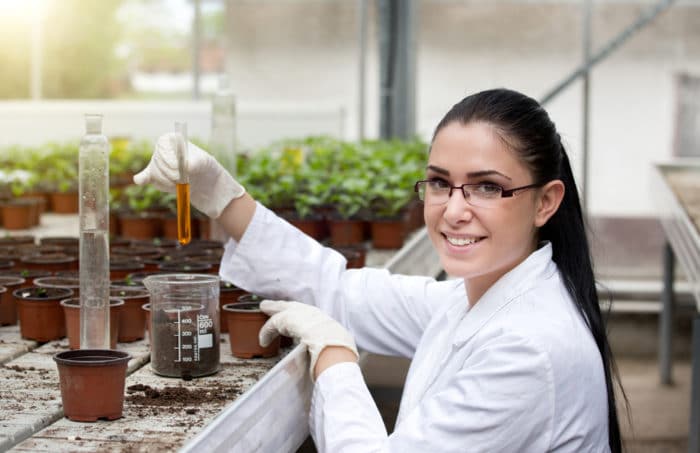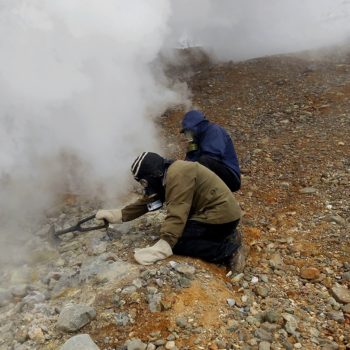Why We Love It
-
$77,190Potential Avg. Salary
-
-0.5%Job Growth Rate
-
Get to TravelCareer Attribute
-
Green JobsCareer Attribute
Botanists are scientists that focus their studies on all forms of plant life. They study every aspect of plants, dissecting plants to study the cells that compose them, researching ways plants can be used in medicine, uncovering ways to grow plants more effectively, and analyzing the environments plants grow in.
Recommended Schools
What is a Botanist?
The following job responsibilities are common for individuals in botanist roles:
- Conduct field work and basic research to discover new plants and plant species
- Deconstruct plants to analyze their construction and determine how they grow, develop, and produce elements or chemicals
- Research ways to grow and care for plants, including defining ideal environments for growth
- Study how plant matter can be used to create food, medicine, or everyday products like cotton or paper
- Research how plants have evolved over time and how they’ve adapted to environment changes
A Day in the Life
Botanists are scientists that focus their studies on all forms of plant life, and their interest in plants can lead them into a variety of diverse careers. Some botanists, called plant taxonomists, conduct field research and travel all over the world to discover new plants. Once a new plant is discovered, these botanists analyze the plant in order to identify and categorize it correctly. Because there are more than a quarter of a million known plants on earth, plant taxonomists play an important role in classifying plants so that they can be distinguished from other, similar plants.
Other botanists work in horticulture and engage in scientific gardening. These botanists are concerned with growing plants and study how to cultivate different plant forms and define what environments and nutrients are ideal for plant growth. These botanists may work at botanical gardens, in greenhouses, for florists, or in agriculture. Agricultural botanists assist farmers with planning for crops, identifying what plants are appropriate for different soil types and providing guidance on caring for crops.
Some botanists choose to work in research and development and investigate how plants can be useful to humans. These botanists may study how plant matter can be used in medicine to combat illness or disease. They may discover new uses for plant matter, forming things like fibers to be used in clothes, paper from trees, or dyes that can be used to alter colors of items. These botanists work alongside scientists, architects, and engineers and use their interest in plants to benefit society as a whole.
Typical Work Schedule
Botanists typically work full-time schedules. While many botany roles are conducted during normal business hours, some botanists may work irregular shifts in evenings or on weekends. In large part, the work schedule for a botanist is determined by the type of positions he/she holds and the employer.
Botanist Specializations
- Plant taxonomists search for, discover, identify, and categorize new plants and species.
- Horticulturists focus on growing plants and managing gardens, flower shops, or greenhouses.
- Biotechnologists research how plants can be used to produce products that are useful to humans.
- Agronomists study agricultural plants and advise farmers and food producers on ways to encourage the growth of plants that are used for food or materials.
Typical Employers
Botanists may work for a wide variety of employers. They may work in research for government agencies or universities, or they may conduct research for pharmaceutical or manufacturing companies. They may also work in agriculture, manage botanical gardens, or own/manage floral shops, greenhouses, or landscaping companies.
Recommended Schools
How To Become a Botanist
For some botanist roles, a high school diploma is a sufficient level of education. This is primarily true for botanists who work in horticulture—those who have a “green thumb” may succeed in the field with no formal postsecondary education. These botanists may run successful greenhouses, floral shops, nurseries, or landscaping companies without ever setting foot on a college campus. However, most successful horticulturists engage in significant self-study to learn about different types of plants and the environments they thrive in.
For other botanist roles, one or more college degrees are required. The first step in becoming a professional botanist in a field outside of horticulture is to earn a bachelor’s degree in biology or botany. Coursework should be focused on biology, botany, chemistry, physics, statistics, and calculus. These courses are important for the types of research and analysis you’ll do as a professional botanist. With a bachelor’s degree, you’ll qualify for entry-level positions in the field.
For more advanced botanist positions like biotechnologist, a master’s degree may be required. Biochemical engineering is a common master’s degree program for this line of work, though other related degrees may be sufficient as well. Some research or teaching roles may also require a Ph.D., but in general, a bachelor’s or master’s degree is a sufficient level of education for most careers in botany.
Botanist Salary Data
We’ve provided you the following to learn more about this career. The salary and growth data on this page comes from recently published Bureau of Labor Statistics data while the recommendations and editorial content are based on our research.
National Anual Salary
Low Range
$57,160Average
$77,190High Range
$112,820National Hourly Wage
Low Range
$27/hrAverage
$37/hrHigh Range
$54/hrHow do Botanist salaries stack up to other jobs across the country? Based on the latest jobs data nationwide, Botanist's can make an average annual salary of $77,190, or $37 per hour. On the lower end, they can make $57,160 or $27 per hour, perhaps when just starting out or based on the state you live in.
Salary Rankings And Facts
#156 Nationally for All Careers
Above Average Salary Nationally
Programs and Degrees
Here are the most common degrees for becoming a Botanist. a is usually recommended and specifically a degree or coursework that prepares you for the particular field, see below.
Highest Education Among Botanists
- 19.6% Doctorate
- 32% Masters
- 43.8% Bachelors
- 2.2% Associates
- 2.1% College
- 0.2% High School
- 0.1% Less than High School
Job Growth Projections and Forecast
2014 Total Jobs
36,4002024 Est. Jobs
36,200Job Growth Rate
-0.5%Est. New Jobs
-200How does Botanist job growth stack up to other jobs across the country? By 2024, there will be a change of -200 jobs for a total of 36,200 people employed in the career nationwide. This is a -0.5% change in growth over the next ten years, giving the career a growth rate nationwide of Above Average.
Growth Rankings And Facts
#626 Nationally for All Careers
Above Avg. Growth Nationally
What Companies Employ The Most Botanists
| Industry | Current Jobs | New Jobs Needed | % Increase |
|---|---|---|---|
| Federal government, excluding postal service | 17,600 | -1,700 | -2% |
| Research and development in the physical, engineering, and life sciences | 5,800 | 400 | 0% |
| Colleges, universities, and professional schools; state | 5,300 | 200 | 0% |














